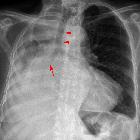Air meniscus sign








An air crescent sign describes the crescent of air that can be seen in invasive aspergillosis, semi-invasive aspergillosis, or other processes that cause pulmonary necrosis. It usually heralds recovery and is the result of increased granulocyte activity.
Terminology
It should not be confused with the Monod sign which describes the air that surrounds an aspergilloma. Unfortunately, the air around the fungal ball is also crescent-shaped and the term air crescent sign is often used interchangeably in that instance - opinion as to the validity of this latter use is controversial.
Pathology
Etiology
Causes include :
- aspergilloma: often described as the Monod sign
- angioinvasive aspergillosis
- hydatid cyst
- other rare causes
- pulmonary tuberculosis
- Rasmussen aneurysm in a tuberculous cavity
- pulmonary abscess
- lung cancer
- pulmonary hematoma
- Pneumocystis jirovecii pneumonia (PJP)
In angioinvasive fungal infection, the nodules are composed of infected hemorrhagic and infarcted lung tissue. As the neutrophil count recovers and the patient mounts an immune response, peripheral reabsorption of necrotic tissue causes the retraction of the infarcted center and air fills the space in between . This creates an air crescent within the nodules and is a good prognostic finding because it marks the recovery phase of the infection. This sign is seen in ~50% of patients .
Siehe auch:
- Lungenkarzinom
- pulmonale Tuberkulose
- Lungenabszess
- Aspergillom
- Echinokokkose
- angioinvasive pulmonale Aspergillose
- left upper lobe collapse
- Aortenbogen
- Pneumocystis jiroveci Pneumonie
- invasive aspergillosis
- Rasmussen-Aneurysma
- chronic necrotising aspergillosis (CNA)
- left upper lobe collapse in the exam
- Monod-Zeichen
- Lungennekrose

 Assoziationen und Differentialdiagnosen zu causes of an air crescent sign:
Assoziationen und Differentialdiagnosen zu causes of an air crescent sign:










